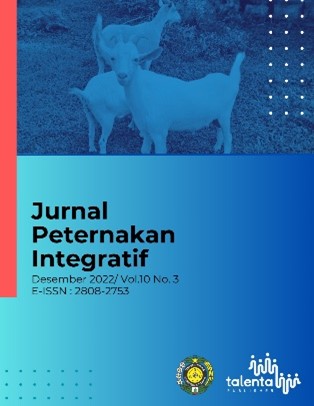Evaluation of the Fiber Content of Maggot (Hermetia Illucens) Growing Media-Based Organic Waste
DOI:
https://doi.org/10.32734/jpi.v10i3.10438Keywords:
ADF, fermentation, hemicellulose, maggot, organic wasteAbstract
Organic waste is waste that can be decomposed entirely from biological processes and is easily decomposed. Organic waste has low nutrient content and high fibre. Efforts are made to increase the low nutrient content and reduce the high fibre content contained in organic waste, then fermented using local microorganisms (MOL). This study aimed to determine changes in fibre content (NDF, ADF and hemicellulose) in various fermented organic wastes. The method is an experimental method with a completely randomized design (CRD) with two factors, namely various organic wastes and fermentation time, with three replications. The parameters of this study consisted of NDF, ADF and Hemicellulose. The study showed that the treatment of various organic wastes had a very significant effect (P < 0.01) on NDF, ADF and hemicellulose. Fermentation time had a very significant effect (P < 0.01) on ADF but had no significant effect (P > 0.05) on NDF and hemicellulose. There was a significant interaction (P < 0.01) between organic waste and fermentation time on ADF content, but there was an interaction with NDF and hemicellulose. Conclusion: Fermentation of various organic wastes and duration of fermentation using local microorganisms (MOL) can reduce the fibre content of NDF, ADF and hemicellulose. The best fermentation was obtained on vegetable media fermented for two days.
Downloads
Downloads
Published
Issue
Section
License
Copyright (c) 2022 Jurnal Peternakan Integratif

This work is licensed under a Creative Commons Attribution-ShareAlike 4.0 International License.
The Authors submitting a manuscript do so on the understanding that if accepted for publication, copyright of the article shall be assigned to Jurnal Peternakan Integratif as well as TALENTA Publisher Universitas Sumatera Utara as the publisher of the journal.
Copyright encompasses exclusive rights to reproduce and deliver the article in all forms and media. The reproduction of any part of this journal, its storage in databases and its transmission by any form or media, will be allowed only with written permission from Jurnal Peternakan Integratif.
The Copyright Transfer Form can be downloaded here.
The copyright form should be signed originally and sent to the Editorial Office in the form of original mail or scanned document.















